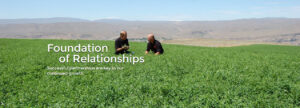 Nitrate levels in feedstuffs may be toxic to livestock. Nitrate poisoning is a serious and often fatal condition that occurs after livestock ingest feedstuffs that contain high levels of nitrate. Some plants amass more nitrate than others. Alfalfa, barley, corn, oats, and wheat are examples of field crops that are nitrate accumulators. Weeds like bindweed, bull thistle, Canadian thistle, and lambsquarter may also have high levels of nitrate. While soil conditions affect nitrate accumulation in plants, weather conditions are the primary influence. During optimal growing conditions, nitrates are easily transformed by plants into proteins and amino acids, resulting in low nitrate levels. In contrast, nitrate concentrations build up in plants when they are stressed during periods of high temperatures, low moisture, and low relative humidity. Overfertilization may also lead to high levels of nitrate in forages and other crops.
Nitrate levels in feedstuffs may be toxic to livestock. Nitrate poisoning is a serious and often fatal condition that occurs after livestock ingest feedstuffs that contain high levels of nitrate. Some plants amass more nitrate than others. Alfalfa, barley, corn, oats, and wheat are examples of field crops that are nitrate accumulators. Weeds like bindweed, bull thistle, Canadian thistle, and lambsquarter may also have high levels of nitrate. While soil conditions affect nitrate accumulation in plants, weather conditions are the primary influence. During optimal growing conditions, nitrates are easily transformed by plants into proteins and amino acids, resulting in low nitrate levels. In contrast, nitrate concentrations build up in plants when they are stressed during periods of high temperatures, low moisture, and low relative humidity. Overfertilization may also lead to high levels of nitrate in forages and other crops.
Nitrate concentrations in forages actually reach their highest levels during the first several weeks after a drought is broken by a significant rainfall event. The increased moisture in the soil after a soaking rain activates bacteria in the soil and results in a large release of nitrate. The stressed plants take up the additional nitrate, but are unable to convert all of it to proteins. Therefore, if possible, restrict access to susceptible pastures or delay harvest of crops during the first few weeks after the end of a drought.
Nitrate poisoning is actually a misnomer. Nitrate by itself is relatively harmless. Toxicity occurs when nitrate is transformed to nitrite. Ruminants, (cattle in particular,) are especially prone to nitrate and nitrite poisoning. Bacteria in the rumen break nitrate down into nitrite, which is further converted into ammonia and then used to form microbial protein. The conversion of nitrate into nitrite occurs at a much faster rate than the conversion of nitrite into ammonia; therefore, nitrite can reach extremely high levels after cattle consume feeds with large amounts of nitrate. Excess ruminal nitrite enters the bloodstream and changes hemoglobin, a protein in blood that carries oxygen, to methemoglobin. The oxygen-carrying capability of blood is consequently diminished because methemoglobin cannot bind to oxygen. As a result, the tissues of affected animals suffer from oxygen starvation. In comparison to ruminants, nitrate poisoning in horses is rather rare because they are hindgut fermenters and do not have rumens. While nitrate is broken down into nitrite in the large intestine, the conversion process does not progress as efficiently or as rapidly as it does in the rumen.
Nitrate poisoning occurs quickly and affected animals may have blue-brown discoloration in unpigmented parts of the body, such as the whites of the eye, lips, and gums. In addition, poisoned animals may exhibit abdominal pain, weakness, unsteady gait, shallow and rapid breathing, rapid heartbeat, abortion in pregnant animals, tremors, convulsions, coma, and eventually death.
Treatment is generally not possible because death usually occurs promptly after poisoning and treated animals rarely recover. However, moderate amounts of nitrate in a feedstuff can be effectively diluted if a low-nitrate feed is offered at the same time. Thus, knowing the nitrate content of feedstuffs offered to livestock is key in preventing nitrate and nitrite toxicity. It is recommended to consult with one’s hay supplier regarding nutrient analyses on purchased hay to alleviate any cause for concern.
For more information on purchasing safe feed, visit Anderson Hay on our website.
References
Allison, C.D., 2010. Nitrate poisoning of livestock. New Mexico State University Cooperative Extension Service Guide h5-807
Oruc, H.H., A. Akkoc, I. Uzunoglu, and E. Kennerman, 2010. Nitrate poisoning in horses associated with ingestion of forage and alfalfa. J. Equine Vet. Sci. 30:159-162.
Warncke, D.D. Nitrate accumulation in drought stressed corn and forages: sampling and testing. http://fieldcrop.msu.edu/uploads/documents/Nitrate%20accumulation%20in%20corn%20forages.pdf


